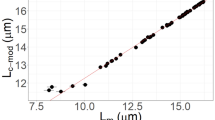Abstract
A linear relationship exists between annealing temperatures and activation energies of fission tracks for different minerals. The temperature and activation energy needed to erase 50% of the tracks in minerals depend on the lattice energy per mole. These relationships make possible predictions about the stability of tracks in silicates, provided their chemical composition is known or a few isochronal annealing data are available.
Similar content being viewed by others
References
Crosaz, G., Haack, U., Hair, M., Maurette, M., Walker, R., Woolum, D.: Nuclear track studies of ancient solar radiations and dynamic lunar surface processes. Proced. Apollo 11 Lunar Sci. Conf. 3, 2051 (1970).
Crosaz, G., Hair, M., Maurette, M., Walker, R. M.: Nuclear interaction tracks in minerals and their implications for extraterrestrial material, Proced. Intern. Topical Conf. on Nuclear Track Registration in Insulating Solids and Applications, VII, p. 41. Clermont-Ferrand 1969.
Deer, W. A., Howie, R. A., Zussman, J.: Rock forming minerals, vol. 2. London: Longmans 1965.
Fleischer, R. L., Price, P. B.: Techniques for geological dating of minerals by chemical etching of fission fragment tracks. Geochim. Cosmochim. Acta 28, 1705 (1964).
Fleischer, R. L., Price, B. P., Symes, E. M.: Fission-track ages and track-annealing behavior of some micas. Science 143, 349 (1964).
Fleischer, R. L., Price, P. B., Walker, R. M.: Effects of temperature, pressure and ionization of the formation and stability of fission tracks in minerals and glasses. J. Geophys. Res. 70, 1497 (1965a).
Fleischer, R. L., Price, P. B., Walker, R. M.: Solid state track detectors: applications to nuclear science and geophysics. Ann. Rev. Nucl. Sci. 15, 1 (1965b).
Fleischer, R. L., Price, P. B., Walker, R. M., Charged particle tracks: tools for geochronology and meteorite studies. In: E. I. Hamilton and R. M. Farquhar (eds.), Radiometric dating for geologists, p. 417. London: Interscience 1968.
Fleischer, R. L., Price, P. B., Walker, R. M.: Fission track dating and processes in the earth's interior. In: S. K. Runcorn (ed.), The application of modern physics to the earth and planetary interiors. p. 499. London: Wiley-Interscience 1969.
Fleischer, R. L., Price, P. B., Walker, R. M., Maurette, M.: Origins of fossil charged-particle tracks in meteorites. J. Geophys. Res. 72, 331 (1967).
Geguzin, Yu. E., Berzina, I. G., Vorab'yeva, I. U.: On the thermal stability of tracks of uranium fission fragments in single crystals of muscovite according to data from chemical etching experiments. Akad. Nauk. SSR. Izv., Sér. Geol. 31, no 6, 21 (1966) [Russian].
Haack, U., Potts, M.: Fission track annealing in garnet. Contr. Mineral. and Petrol. 34, 343 (1972).
Maurette, M.: Track formation mechanisms in minerals. Proced. Intern. Topical Conf. on Nuclear Track Registration in Insolating Solids and Applications, I, p. 2. Clermont-Ferrand 1969.
Maurette, M., Pellas, P., Walker, R. M.: Étude des traces de fission fossiles dans le mica. Bull. Soc. Franç. Minéral. Crist. 87, 6 (1964).
Metha, P. P., Rama: Annealing effects in muscovite and their influence on dating by fission track method. Earth Planet. Sci. Letters 7, 82 (1969).
Naeser, C. W., Engels, J. C., Dodge, F. C. W.: Fission track annealing and age determination of epidote minerals. J. Geophys. Res. 75, 1579 (1970).
Naeser, C. W., Faul, H.: Fission track annealing in apatite and sphene. J. Geophys. Res. 74, 705 (1969).
Saukow, A. A.: Geochemie. Berlin: VEB Verlag Technik 1953.
Seitz, M.: Priv. communication (1972).
Seitz, M., Wittels, M. C., Maurette, M., Walker, R. M.: Accelerator irrations of minerals: Implications for track formation mechanisms and for studies of lunar and meteoritic minerals. Proc. Intern. Topical Conference on Nuclear Track Registration in Insolating Solids and Applications, VII, p. 55. Clermont-Ferrand 1969.
Shukolyukow, Yu. A., Krylov, I. N., Tolstikhin, I. N., Ovchinnikova, G. V.: Tracks of uranium fission fragments in muscovite. Geochemicstry International, translated from Geokhimiya 3, 291 (1965).
Wagner, G.: Spuren der spontanen Kernspaltung des 238 Urans als Mittel zur Datierung von Apatiten und ein Beitrag zur Geochronologie des Odenwaldes. Ph. D. thesis, University of Heidelberg (1967).
Vand, V.: A theory of the irreversible electrical resistance changes of metallic films evaporated in vacuum. Proc. Phys. Soc. (London) 55, no. 309, 222 (1943).
Author information
Authors and Affiliations
Rights and permissions
About this article
Cite this article
Haack, U. Systematics in the fission track annealing of minerals. Contr. Mineral. and Petrol. 35, 303–312 (1972). https://doi.org/10.1007/BF00371312
Received:
Issue Date:
DOI: https://doi.org/10.1007/BF00371312



